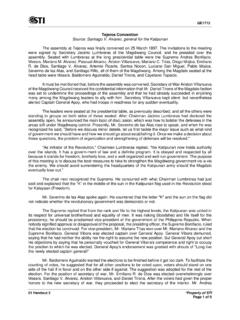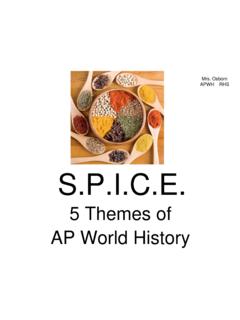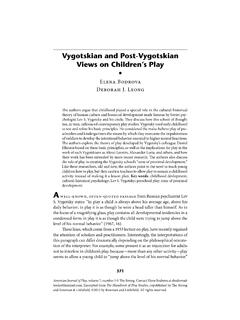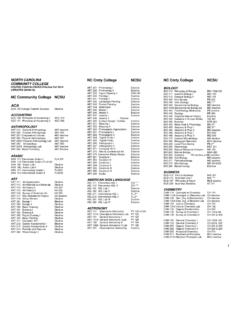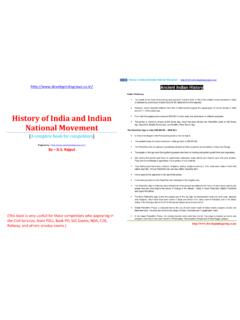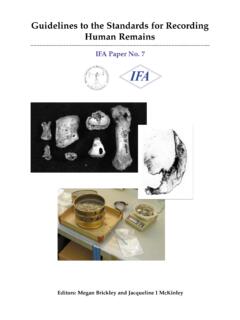Transcription of A HISTORY OF SCIENCE AND TECHNOLOGY IN THE …
1 GE1713 01 Readings 4 *Property of STI Page 1 of 19 A HISTORY OF SCIENCE AND TECHNOLOGY IN THE PHILIPPINES by Olivia C. Caoili** Introduction The need to develop a country's SCIENCE and TECHNOLOGY has generally been recognized as one of the imperatives of socioeconomic progress in the contemporary world. This has become a widespread concern of governments especially since the post world war 11 Among Third World countries, an important dimension of this concern is the problem of dependence in SCIENCE and TECHNOLOGY as this is closely tied up with the integrity of their political sovereignty and economic self-reliance. There exists a continuing imbalance between scientific and technological development among contemporary states with 98 per cent of all research and development facilities located in developed countries and almost wholly concerned with the latter's problems2 Dependence or autonomy in SCIENCE and TECHNOLOGY has been a salient issue in conferences sponsored by the United It is within the above context that this paper attempts to examine the HISTORY of SCIENCE and TECHNOLOGY in the Philippines.
2 Rather than focusing simply on a straight chronology of events, it seeks to interpret and analyze the interdependent effects of geography, colonial trade, economic and educational policies and socio-cultural factors in shaping the evolution of present Philippine SCIENCE and TECHNOLOGY . As used in this paper, SCIENCE is concerned with the systematic understanding and explanation of the laws of nature. Scientific activity centers on research, the end result of which is the discovery or production of new This new knowledge may or may not have any direct or immediate application. In comparison, TECHNOLOGY has often been understood as the "systematic knowledge of the industrial arts."5 As this knowledge was implemented by means of techniques, TECHNOLOGY has become commonly taken to mean both the knowledge and the means of its utilization, that is, "a body, of knowledge about techniques."6 Modern TECHNOLOGY also involves systematic research but its outcome is more concrete than SCIENCE , the production of "a thing, a chemical, a process, something to be bought and sold.
3 "7 In the past, SCIENCE , and TECHNOLOGY developed separately, with the latter being largely a product of trial and error in response to a particular human need. In modern times, however, the progress of SCIENCE and TECHNOLOGY have become intimately linked together. Many scientific discoveries have been facilitated by the development of new TECHNOLOGY . New scientific knowledge, in turn, has often led to further refinement of existing TECHNOLOGY or the invention of entirely new ones. Precolonial SCIENCE and TECHNOLOGY There is a very little reliable written information about Philippine society, culture, and TECHNOLOGY before the arrival of the Spaniards in As such, one has to reconstruct a picture of this past using 1 For a brief summary of the evolution of government concern for the development of SCIENCE and TECHNOLOGY , see Olivia C. Caoili, Dimensions of SCIENCE Policy and National Development: The Philippine Experience, Monograph Series No.
4 1 (College, Laguna: Center for Policy and Development Studies, University of the Philippines at Los Banos, October 1982), pp. 4-34. 2 Guy B. Gresford and Bertrand H. Chate, l " SCIENCE and TECHNOLOGY in the United Nations," World Development, Vol. II (January 1974), p. 44. 3 See, for example, UNESCO, SCIENCE and TECHNOLOGY in Asian Development: Conference and Application of SCIENCE and TECHNOLOGY to the Development of Asia, New Delhi, August 1968 (Paris: UNESCO, 1970); United Nations Conference on SCIENCE and TECHNOLOGY for Development, Vienna, Austria, 1979, in Nature, Vol. 280 (16 August 1979), pp. 525-532. 4 Jerome R. Ravetz, Scientific knowledge and Its Social Problems (Oxford: Clarendon Press, 1971), chap. 1; James B. Conant, SCIENCE and Common Sense (New Haven and London: Yale University Press, 1974), chap. 2; Bernard Dixon, What is SCIENCE For? (New York: Harper and Row, 1973), chap. 2: David Knight, The Nature of SCIENCE : The HISTORY of SCIENCE in Western Culture Since 1600 (London: Andre Deutsch, 1976), chaps.
5 1-2. 5 E. Layton, "Conditions of Technological Development" in Ina Spiegel-Rosing and Derek de Solla Price, eds., SCIENCE , TECHNOLOGY and Society, A Cross-Disciplinary Perspective (London and Beverly Hills: Sage Publications, 1977), p. 199. 6 C. Freeman, "Economics of Research and Development." in Rosing and Price, ibid., p. 235. 7 Derek de Solla Price SCIENCE Since Babylon (Enlarged ed.; New Haven: Yale University Press, 1975), 8 William Henry Scott in Prehispanic Source Materials for the Study of Philippine HISTORY (Rev. ed.; Quezon City: New Day Publishers, 1984), asserts that there are only two authentic medieval Chinese accounts about prehispanic Philippines. He GE1713 01 Readings 4 *Property of STI Page 2 of 19 contemporary archaeological findings, accounts by early traders and foreign travelers, and the narratives about conditions in the archipelago which were written by the first Spanish missionaries and colonial officials. According to these sources, there were numerous, scattered, thriving, relatively self-sufficient and autonomous communities long before the Spaniards arrived.
6 The early Filipinos had attained a generally simple level of technological development, compared with those of the Chinese and Japanese, but this was sufficient for their needs at that period of time. Archaeological findings indicate that modern men (homo sapiens) from the Asian mainland first came over-land and across narrow channels to live in Palawan and Batangas around 50,000 years ago. For about 40,000 years, they made simple tools or weapons of stone flakes but eventually developed techniques for sawing, drilling and polishing hard stones. These Stone Age inhabitants subsequently formed settlements in the major Philippine islands such as Sulu, Mindanao (Zamboanga, and Davao), Negros, Samar, Luzon (Batangas, Laguna, Rizal, Bulacan and the Cagayan region). By about 3,000 , they were producing adzes ornaments of seashells and pottery of various designs. The manufacture of pottery subsequently became well developed and flourished for about 2,000 years until it came into competition with imported Chinese porcelain.
7 Thus over time pottery making declined. What has survived of this ancient TECHNOLOGY is the lowest level, , the present manufacture of the ordinary cooking pot among several local communities. 9 Gradually, the early Filipinos learned to make metal tools and implements -- copper, gold, bronze and, later, iron. The iron age is considered to have lasted from the second or third century to the tenth century AD. Excavations of Philippine graves and work sites have yielded iron slags. These suggest that Filipinos during this period engaged in the actual extraction of iron from ore, smelting, and refining. But it appears that the iron industry, like the manufacture of pottery, did not survive the competition with imported cast iron from Sarawak and much later, from By the first century A D., Filipinos were weaving cotton, smelting iron, making pottery and glass ornaments and were also engaged in agriculture. Lowland rice was cultivated in diked fields, and in the interior mountain regions as in the Cordillera, in terraced fields which utilized spring Filipinos had also learned to build boats for the coastal trade.
8 By the tenth century , this had become a highly developed TECHNOLOGY . In fact, the early Spanish chroniclers took note of the refined plank-built warship called caracoa. These boats were well suited for inter-island trade raids. The Spaniards later utilized Filipino expertise in boat-building and seamanship to fight the raiding Dutch, Portuguese, Muslims and the Chinese pirate Limahong as well as to build and man the galleons that sailed to Mexico. 12 By the tenth century A D., the inhabitants of Butuan were trading with Champa (Vietnam); those of Ma-i (Mindoro) with China. Chinese records with have now been translated contain a lot of references to the Philippines. These indicate that regular trade relations between the two countries had been well established during the tenth to the fifteenth centuries. Archaeological findings (in various parts of the archipelago) of Chinese porcelains made during this period support this contention. From the Sung (960-1278) and Yuan (1260-1368) Dynasties, there are descriptions of trade with the Philippines, and from the Sung and Ming (1360-1644) Dynasties there are notices of Filipino missions to The most frequently cited Chinese account in Philippine HISTORY textbooks is that of Chao Ju-Kua in 1225.
9 Points out questionable documents which have been the basis for information about this period and which were popularized in Philippines HISTORY textbooks, including theories that have been mistaken for facts. Cf. Otley Beyer, "The Philippines before Magellan," and Robert B. Fox, "The Philippines in Prehistoric Times," in readings in Philippine prehistory (Manila: Filipiniana Book Guild, 1979), Second Series, Vol. I, pp. 8-34; 35-61. 9 Scott, op. cit., pp. 20-22. 10 Ibid., pp. 18-19 11 Ibid., pp. 136-137; Fox. , pp. 49-50. 12 Antonio de Morga, Sucesos de las Islas Filipinas, first published in 1609, trans. and ed. by Cummins (Cambridge: Published for the Hakluyt Society at Cambridge University Press, 1971), pp. 252-253; Francisco Colin, Labor Evangelica (1663) in Horacio de la Costa, , Readings in Philippine HISTORY (Manila: Bookmark, 1965), p. 9; William Henry Scott, "Boat-Building and Seamanship in Classic Philippine Society," in Cracks in the Parchment Curtain and Other Essays in Philippine HISTORY (Quezon City: New Day Publis hers, 1982), pp.
10 60-96. 13 See Scott, Prehispanic Source , chap. 3; Berthold Laufer, "The Relations of the Chinese to the Philippines," in Readings in Philippine prehistory , pp. 142-177; Austin Craig, "A Thousand Years of Philippine HISTORY Before the Coming of the Spaniards," in ibid., pp. 128-141. GE1713 01 Readings 4 *Property of STI Page 3 of 19 He described the communities and trading activities in the islands of Ma-i (Mindoro) and San-hsu (literally three islands which present-day historians think refer to the group of Palawan and Calamian lslands).14 The people of Ma-i and San-hsu traded beeswax, cotton, true pearls, tortoise shell, medicinal betelnuts, yu-ta cloth (probably jute or ramie?) and coconut heart mats for Chinese porcelain, iron pots, lead fishnet sinkers, colored glass beads, iron needles, and tin. These were practically the same commodities of trade between the islands and China which the first Spanish colonial officials recorded when they came to the Philippines more than two centuries The Filipinos in Mindanao and Sulu traded with Borneo, Malacca, and parts of the Malay peninsula.




